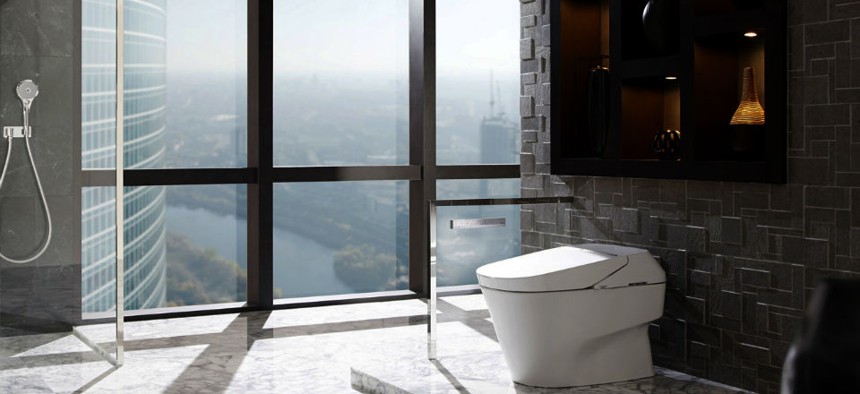A Fake Toilet Company Raises Legitimate Questions About Government Data-Tracking

A NEOREST 750H high tech toilet. TOTO/AP
Even the most intimate spaces are becoming public.
I wasn't actually surprised to learn that public officials in Toronto had agreed to install "smart toilets" in the city's convention center so they could analyze public, um, data. As a privacy researcher, the idea fascinated me.
Only problem: It wasn’t true.
But a fake toilet company’s publicity stunt has me thinking, which is what Quantified Toilets intended. Smart toilets are just the kind of product you expect to encounter at the ACM Conference on Human Factors in Computing , or CHI, an annual event where researchers discuss the latest science of how people interact with technology. This is my favorite conference to attend. There are always new and cool projects that make me think.
So when Quantified Toilets debuted at CHI this week, it was an immediate hit. The company claimed to have installed sensors in the Toronto Convention Center and other civic venues that would automatically analyze “deposits” in the toilets to detect a person’s gender, drug and alcohol levels, pregnancy status, sexually-transmitted-infection status, and… smell.
There were signs in the bathrooms that read: “Behavior at these toilets is being recorded for analysis.”

The accompanying website featured a live stream (ha) of toilet data being collected in real time.

The idea isn’t as absurd as it may sound, especially to a cohort of conference attendees who spend their days thinking about these sorts of technologies. “Smart toilets” have been around for a while, and in a survey by Intel and market researcher Penn Schoen Berland, 70% of people said they would be willing to share their smart toilet data if it led to lower healthcare costs .
But this was different. And it's worth exploring why.
If the government installs smart toilets in public venues, the option to opt out isn’t necessarily available. Bathroom access is essential in public spaces, and leaving a convention center to find an unmonitored toilet is a burden. There’s also something troubling about health data that’s not collected for use by a physician—or even an insurance company—but gathered in public by and for the government.
This is the kind of data that public officials or marketers would love to obtain. Let’s imagine a couple scenarios:
-
At a convention or concert, an organization could determine whether attendees have high rates of pregnant women with positive drug or alcohol tests, then use that knowledge to target public health messages to the demographic.
-
In stadiums, an organization could see which sections had higher blood alcohol levels, and even the peak levels during the game. They could market more beer to that section—or make it harder for people in that section to buy drinks. They might even sell this data to beer vendors willing to pay for such demographic information.
-
Other ideas from the Quantified Toilets website : “We use this data to streamline cleaning crew schedules, inform municipalities of the usage of resources, and help buildings and cities plan for healthier and happier citizens.”
If sensors were to be as easily deployed as the website suggests, they could be used in not-so-anonymous settings like offices. Your employer could find out which drugs employees are taking, check to see if anyone shows up to work drunk, and figure out which female employees are expecting babies.
As individuals, we are already tracking our physical activity with Fitbits, our physical locations with cell phones, our eating habits with websites like MyFitnessPal, and even our genomes with services like 23 and Me. But there’s a critical line between the “quantified self movement”—in which people record as much personal metadata as possible—and public monitoring of our data.
A sensor in the convention-center toilet is a lot more like a public surveillance camera than it is a private fitness app. But it wasn’t until I reached out to Quantified Toilet to learn more that I found out what was really going on. An excerpt from the auto-reply email I received:
“As you may have worked out, Quantified Toilets is indeed a fake company and all data reported were equally fake. It was a thought experiment at CHI 2014, designed to engender thought and discussion regarding the issues of surveillance, data, and privacy.”
It worked. Quantified Toilet got me thinking about issues that are integral to the way we assess the interplay between technology and privacy. The concerns these hypothetical toilets raise will only continue to come up as smart technologies become more integrated with daily life.
While the project may have been a hoax, surveillance in public spaces is rising—and it isn’t restricted to cameras. There are sophisticated sensors for monitoring all kinds of activities.
My colleague Jon Froehlich designed a sensor that can detect water use in each of a house’s fixtures —including the toilets—by screwing the sensor into the outdoor garden-hose spigot.
Sensors of all types are easily connected to the Internet. They can collect vast amounts of data, which can then be shared widely. As citizens, we don’t always know what data is being collected, who can access it, or how it will be used. Even seemingly secure networks can be comprised.
We should be leading conversations about the legal privacy protections we need to establish for what once seemed to be private activities. In a data-rich connected world, even the most intimate spaces are becoming public.
NEXT STORY: Science council approves big-data privacy report


